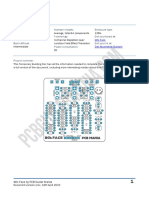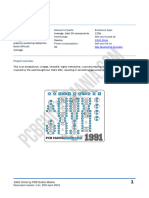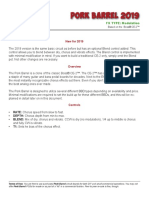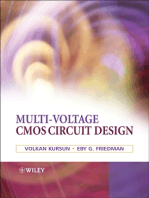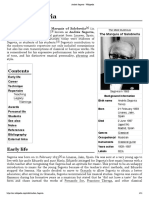Black Sun of Doom 1v1 Building Docs
Black Sun of Doom 1v1 Building Docs
Uploaded by
Vincent ButtigeCopyright:
Available Formats
Black Sun of Doom 1v1 Building Docs
Black Sun of Doom 1v1 Building Docs
Uploaded by
Vincent ButtigeOriginal Title
Copyright
Available Formats
Share this document
Did you find this document useful?
Is this content inappropriate?
Copyright:
Available Formats
Black Sun of Doom 1v1 Building Docs
Black Sun of Doom 1v1 Building Docs
Uploaded by
Vincent ButtigeCopyright:
Available Formats
Black Sun of Doom
Based on: Amount of parts: Enclosure type:
Coda Effects Black Hole High, total 70 components 1590bb
Effect type: Technology: Get your board at:
High gain Preamp + Booster JFET + Op-amp gain recovery Black Sun of Doom
Build difficult: Power consumption: Get your kit at:
Advanced 9V Das Musikding (Europe)
Project overview:
JFET Sunn Model T in a box, featuring dual-channel, extended EQ section featuring Depth and Presence
control like Benzin VH4(link). This board also includes an LPB1 booster at the beginning of the signal
path for getting things even nastier.
Black Sun of Doom by PCB Guitar Mania 1
Board version 1.1v, 17th March 2023
Index
1. Project overview 5. Schematic
2. Index, Introduction & Controls 6. Components, Build Notes
3. Bills of Materials, BOM 7. Wiring Diagram, Drill Template
4. Shopping Lists 8. Licensing and Usage
Introduction
Sunn amps are some of the most regarded in the guitarist community due to their huge thick sound, deep
bass, and loudness. Every Stoner rocker dream!
However, these amplifiers can get pretty rare and expensive to purchase, often going for price tags above
$3000. Even the 2008 Fender reissue can be quite hard to find.
The Sunn tone demand increased incredibly fast through the years due to the hype generated online, with
many pedals claiming to nail its tone. Maybe the most popular being EQD Acapulco Gold, which delivers
quite good tones but not even close to the Sunn Model T.
Meanwhile, in France, Coda effects developed the Black Hole, following the Sunn Model T's original
schematic, replacing the tubes for JFETS and making some other adjustments to squeeze more gain out
of it we did with our Lemon Rockverb (link).
After being blown away by the Black Hole's tone, I started asking myself, ' How can we make this even
better?' So, I started experimenting with the EQ section, which most often the weakest point of the JFET
preamps in a box.
I wanted to try some of the EQs sections we have seen in other modern amps in a box, just like our Active
EQ or Hybrid eq, both from Freeman BEOD or the Revvolution series, respectively (links in every name).
Finally, choosing Benzin EQ as the winner. Keeping the traditional structure of an amp alike tone stack,
while adding a Depth control to make your bass growl and a presence knob to make sure you'll cut through
the mixes, as a cherry on the top, we have a recovery gain stage after the tone stack, making sure this
beast will tear your house down.
Controls
BASS DEEP PRES
BOOST MIDS TREBLE
BRIGHT NORMAL VOL1
Black Sun of Doom by PCB Guitar Mania 2
Document version 1.1v, 17th March 2023
Bill of materials
Resistors C2 22nf VOL1 10K A
Part Value C3 470p
R1 68k C4 220p
R2 1m C6 22n Trimmers
R3 68k C7 22n Part Values
R4 1m C8 270p BIAS1 20k
R5 680r C9 330n BIAS2 20k
R6 470k C16 1n BIAS3 20k
R7 470k C19 2n2
R8 820r C22 330n
IC
R9 100k CB1 100n
Part Value
R10 56k CB2 100n
IC1 TL072CP
R11 56k
R12 56k
Electrolytic Capacitors
R19 1m Switches
Part Value
R20 10k Part Value
C5 22u
R21 4k7 Out Up SPDT ON/ON
C10 47u
R22 1k BOOSTER 3PDT
C12 47u
R23 56k
C13 220u
R24 100k
C17 10u Transistors
R25 100r
C18 10u Part Value
R26 56k
C20 2u2 Q1 J201
R27 47r
C21 1u Q2 J201
R30 1k
RB1 1m Q3 J201
RB2 470k Q4 J201
Potentiometers
RB3 47k Q5 2N5088
Part Value
RB4 10k BASS 1M A
RB5 390r BOOST 100K B Diodes
CRL 4k7 BRIGHT 1M A Part Value
CRL1 4k7 DEEP 25K C D0 1N5817
MIDS 25K B D1 LED 3mm
NORMAL 1M A D2 LED 3mm
Capacitors
PRES 25K C
Part Value
TREBLE 250K B
C1 22n
Black Sun of Doom by PCB Guitar Mania 3
Document version 1.1v, 17th March 2023
Shopping list
Resistors 3 22n C1, C6, C7 Trimmers
Qty Value Parts 1 22nf C2 Qty Value Parts
1 100k R24 1 270p C8 3 20k BIAS1,
1 100r R25 1 2n2 C19 BIAS2,
2 10k R20, RB4 2 330n C9, C22 BIAS3
2 1k R22, R30 1 470p C3
1 47r R27 IC
3 4k7 R21, CRL, Electrolytic Capacitors Qty Value Parts
CRL1
Qty Value Parts 1 TL072CP IC1
5 56k R10, R11,
R12, R23, 1 22u C5
R26 2 47u C10, C12
2 68k R1, R3 1 220u C13 Switches
3 1m R2, R4, 2 10u C17, C18 Qty Value Parts
R19, RB1 1 1u C21 1 SPDT Out Up
1 680r R5 ON/ON
1 2u2 C20
1 47k RB3 1 3PDT BOOSTER
3 470k R6, R7,
RB2 Potentiometers
1 820r R8 Transistors
Qty Value Parts
1 100k R9 Qty Value Parts
1 100k B BOOST
1 390r RB5 1 10K A VOL1 1 2N5088 Q5
2 1M A BRIGHT, 4 J201 Q1, Q2,
NORMAL Q3, Q4
Capacitors 2 25K C DEEP,
Qty Value Parts PRES
1 100n CB2 1 1M A BASS Diodes
1 100n CB1 1 250K B TREBLE Qty Value Parts
1 1n C16 1 25K B MIDS 2 LED 3mm D1, D2
1 220p C4
1 1N5817 D0
Black Sun of Doom by PCB Guitar Mania 4
Document version 1.1v, 17th March 2023
Schematic
Black Sun of Doom by PCB Guitar Mania 5
Document version 1.1v, 17th March 2023
Components Recommendations
As many people like to experiment with some pedals with higher voltage, always ensure
your electrolytic capacitors' max tolerance is over 25v.
This board has been tested using Film box capacitors for most of the values over 1nf and ceramics discs
for those under 1nf. However, high-quality components such as Wima's Capacitors and Panasonic's
electrolytics can deliver a better performance.
All the resistors used for testing this project are 1/4W Metal Film.
The BOM and Shopping list are exclusive regarding this project. It doesn't include all the hardware like the
3PDT bypass switch, audio/dc jacks, enclosure, etc.
Build Notes
If this is one of your first projects, I recommend you to take a look at our Pedal Building Guide.
For a successful and tidy build, it’s recommended the following order:
1. Resistors & diodes
2. Capacitors, starting with the smaller ones and the ceramic ones.
3. Electrolytic capacitors (always check the polarity)
4. Transistors
5. Wires
6. Potentiometers and switches
7. Off-board wiring
Remember, this project requires sourcing some good quality JFET from trusted sources for proper
functioning. We always recommend using SMD JFET as their reliability is far superior to the discontinued
through-hole counterpart. Also, bear in mind this project requires bias the transistors correctly with the
respective trim pots.
To do this correctly, plug the pedal into your 9v power supply/battery, grab your multimeter and plug the
black terminal into any ground of the circuit. Simultaneously, with the read touch, the Drain legs of your
transistors, if it's done correctly, should appear how much voltage is receiving that leg.
Now turn the trimpot with a screwdriver till you can read 4.5v- or half of your power supply; in case you are
using 18v- on the screen of your multimeter. Repeat this process with all transistors and their respective
trimpots till all of them are measuring 4.5v, then proceed to do fine-tuning by ear on what you hear are the
best settings of each transistor. Don't forget to share your favorite bias settings and pictures of your build
on our Facebook group!
Black Sun of Doom by PCB Guitar Mania 6
Document version 1.1v, 17th March 2023
Wiring Diagram
All our projects include a free 3PDT Board to make the wiring easier and tidier. Also, all of our PCBs feature
the status LED on board.
The pad named “Ctrl” or “LED” is the one that controls the status of the led; wire it to the “LED” pad on the
3PDT board or in the control slug of your 3PDT.
This board has been designed to match our EZ 3PDT PCB; check it here to access our Pedal Wiring Guide.
PRES 1 GND TREBLE GND9V
1 MIDS 1 PW-OUT BASS 1
1 D0 C6
R30 C16 R27 C7
IC1
R21 R20 VOL R26 C8
R25 R19 C22
C1 8
R22
C21
C20
1
C3 C4 C9
Q3
Q4
C17
C5
BIAS3
1 1 1
BRIGHT 1 DEEP 1 NORMAL
C1 C2
C1 2
Q2 Q1
C1 3
BIAS2 Q5 BIAS1
CB2
R24
CB1
R23
C19
BOOST 1 VOL1 1
D2 D1
BOOSTER
A B C INPUTCTRLGND OUT
1 2 3 4 5 6 7 8 9
Always place the
3PDT like this!
Black Sun of Doom by PCB Guitar Mania 7
Document version 1.1v, 17th March 2023
Drill Template
This Project has been planned to fit into a 1590bb enclosure type.
Check the Attached “Drilling templates” to drill the box properly. The files are on Scale 1:1, ready to print
on an A4 page.
Licensing and Usage
We really appreciate your trust and support in buying this PCB, as well as your will to dive into the DIY
electronics world. For us, that's why you can make this project work properly and enjoy not only the building
process but also experiment and play with it on your rig.
We try to reply to every question we receive on our email or our social media. Still, we try to encourage all
our customers to join our PCB Guitar Mania – Builders Group on Facebook to post all your doubts, issues,
suggestions, or requests, share your builds, and have some feedback from other fellow builders and us!
We tested all our projects following this same guide on their standard configurations. Although, not all of
the variations and mods have necessarily been checked. These are suggestions based on the schematic
analysis and the experiences and opinions of others. Feel free to share with us your views and
recommendations regarding the mods your personal experimentation.
These boards may be used for commercial endeavors in any quantity unless expressly noted. No attribution
is necessary, though accreditation or a link back is always much appreciated.
If you are a builder planning to make your own run of pedals, we also offer the service of custom-made
boards with your brand and logo, design according to your specifications.
The only usage restrictions are that, first, you cannot resell the PCB as part of a kit without prior
arrangement with us, and second, you cannot scratch off the silkscreen or other way of trying to hide our
logos and the source of the PCBs. Like it's written above, if you want to have your designs with your brand
and logo, we could undoubtedly reach an agreement.
Follow us on Instagram and Facebook to stay in tune with the latest projects!
Black Sun of Doom by PCB Guitar Mania 8
Document version 1.1v, 17th March 2023
You might also like
- Homes & Interiors Scotland - March-April 2024Document252 pagesHomes & Interiors Scotland - March-April 2024reader_javaNo ratings yet
- DFMEA-Power Window Motor - VEMDocument14 pagesDFMEA-Power Window Motor - VEMavmr67% (3)
- Freeman BE OD Building Docs 1Document7 pagesFreeman BE OD Building Docs 1Cleber KébiNo ratings yet
- Death by Reverb Building DocsDocument7 pagesDeath by Reverb Building DocsLuis TeránNo ratings yet
- Warped Plexi Deluxe Building DocsDocument8 pagesWarped Plexi Deluxe Building DocsVincent ButtigeNo ratings yet
- Magnetic Delay - Building DocsDocument7 pagesMagnetic Delay - Building DocsLucio M.No ratings yet
- Rectifier Box 2v Building Docs4Document9 pagesRectifier Box 2v Building Docs4nemazokniNo ratings yet
- Sinner-Amp-Building-DocsDocument10 pagesSinner-Amp-Building-DocsRica TheSickNo ratings yet
- Kloned Centaur 1v2 Building DocsDocument7 pagesKloned Centaur 1v2 Building DocsfabrifiorettiNo ratings yet
- Poly Pig - Building DocsDocument7 pagesPoly Pig - Building DocsLucio M.No ratings yet
- Muff Malo - Building DocsDocument7 pagesMuff Malo - Building DocsLucio M.No ratings yet
- Pleximan - Building DocsDocument8 pagesPleximan - Building DocsLucio M.No ratings yet
- Based On Fulltone OCD Overdrive - Distortion by PCB Guitar Mania ManiaDocument6 pagesBased On Fulltone OCD Overdrive - Distortion by PCB Guitar Mania ManiaBookswap EUNo ratings yet
- Elk Device Building Docs 15th February 2023Document9 pagesElk Device Building Docs 15th February 2023Vincent ButtigeNo ratings yet
- Crysis Building DocsDocument8 pagesCrysis Building DocsMat DowerNo ratings yet
- Shotgun 1v1 - Building DocsDocument9 pagesShotgun 1v1 - Building DocsLucio M.No ratings yet
- Eagle Claw BuildingDocument7 pagesEagle Claw BuildingBepe uptp5aNo ratings yet
- The Blender Building DocsDocument8 pagesThe Blender Building DocsMomcilo DakovicNo ratings yet
- Electric Lover: Based On EHX's Electric Mistress Flanger by PCB Guitar Mania ManiaDocument4 pagesElectric Lover: Based On EHX's Electric Mistress Flanger by PCB Guitar Mania ManiaDavid BrownNo ratings yet
- Mad Blue Delay Building DocsDocument8 pagesMad Blue Delay Building Docsmaurcio peiranoNo ratings yet
- Carbon BlackDocument9 pagesCarbon BlackmanecolooperNo ratings yet
- Tremolo Factory 1.2v Building Docs2231Document7 pagesTremolo Factory 1.2v Building Docs2231Vincent ButtigeNo ratings yet
- 90's FaceDocument6 pages90's FaceDavid BrownNo ratings yet
- Revolution IV Drilling TemplateDocument11 pagesRevolution IV Drilling TemplateAndreNo ratings yet
- 1991 Drive - Building DocsDocument7 pages1991 Drive - Building DocsLucio M.No ratings yet
- Andromeda Legacy DocumentationDocument6 pagesAndromeda Legacy DocumentationBruno BoaventuraNo ratings yet
- Black Mirror VII Building DocsDocument8 pagesBlack Mirror VII Building DocsUman KinapNo ratings yet
- Humble Overdrive 1.1v Building Docs1Document10 pagesHumble Overdrive 1.1v Building Docs1saul palafoxNo ratings yet
- Pure VCO Build Doc 201507012Document38 pagesPure VCO Build Doc 201507012Dan PisciottaNo ratings yet
- Mad Honey Building DocsDocument8 pagesMad Honey Building DocsDakovic AleksandarNo ratings yet
- Black Mirror VII 1.1v - Building Docs (09-05-2023)Document13 pagesBlack Mirror VII 1.1v - Building Docs (09-05-2023)Lucio M.No ratings yet
- Arsonist: Based On The TC Electronic ® Spark Booster™Document5 pagesArsonist: Based On The TC Electronic ® Spark Booster™Gurito FuentesNo ratings yet
- Black Mirror VII v1.5Document13 pagesBlack Mirror VII v1.5David BrownNo ratings yet
- GateKeeper BuildDocument5 pagesGateKeeper BuildEber HernandezNo ratings yet
- Pork Barrel 2019: New For 2019Document11 pagesPork Barrel 2019: New For 2019dNo ratings yet
- Vulcan Drive: Bill of MaterialsDocument5 pagesVulcan Drive: Bill of MaterialsMiroslav MaksimovićNo ratings yet
- Lowrider2015Document9 pagesLowrider2015Andrés GaleottiNo ratings yet
- Ocd Datasheet 010817Document5 pagesOcd Datasheet 010817Sebastiano MuratoreNo ratings yet
- Uberdrive - Building DocsDocument8 pagesUberdrive - Building DocsLucio M.No ratings yet
- Bomenbendermk 3Document1 pageBomenbendermk 3Julio C. Ortiz MesiasNo ratings yet
- Cosmos Delay Building DocsDocument11 pagesCosmos Delay Building DocsLeonardo HalfeldNo ratings yet
- XR2206 - Lista de MaterialDocument1 pageXR2206 - Lista de Materialradiotron1953No ratings yet
- Rainbow PukerDocument13 pagesRainbow PukermorbidpaleNo ratings yet
- Dirtbaby Delay Madbeans SchemeaticDocument8 pagesDirtbaby Delay Madbeans SchemeaticYuri SilvaNo ratings yet
- Camber EQ: Based On: Amount of Parts: Power Consumption: Enclosure Type: Get Your Board At: Get Your Kit atDocument7 pagesCamber EQ: Based On: Amount of Parts: Power Consumption: Enclosure Type: Get Your Board At: Get Your Kit atDavid BrownNo ratings yet
- Neutrino Ver.3Document3 pagesNeutrino Ver.3Luis BesadaNo ratings yet
- FX10 Build DocDocument4 pagesFX10 Build DocIndymaru EngenhariaNo ratings yet
- Need For Tweed BuildDocument4 pagesNeed For Tweed BuildkarulovNo ratings yet
- MDD EffectDocument9 pagesMDD EffectkascelNo ratings yet
- Arcadiator Build Doc v1B UpdatedDocument1 pageArcadiator Build Doc v1B UpdatedEdward JonesNo ratings yet
- Moodring 2017Document12 pagesMoodring 2017Rafik HergéNo ratings yet
- Angler: Based On The Mad Professor® Sea Blue EQ™Document4 pagesAngler: Based On The Mad Professor® Sea Blue EQ™Alberto de Oliveira Jr.No ratings yet
- Punk N PiDocument8 pagesPunk N PiThành NguyễnNo ratings yet
- EgoDriver Ver3Document4 pagesEgoDriver Ver3Gustavo Ernesto Alvarez PobleteNo ratings yet
- Slurpee: © 2016 MadbeanpedalsDocument5 pagesSlurpee: © 2016 MadbeanpedalsAlberto de Oliveira Jr.No ratings yet
- Retrograde 2019Document8 pagesRetrograde 2019wildbuckalewNo ratings yet
- ZW 44 EngDocument3 pagesZW 44 EngBabarNo ratings yet
- Tweed Bassman 59 SMD Building DocsDocument8 pagesTweed Bassman 59 SMD Building Docsmatheuschagas2007No ratings yet
- Valv e Tizer V15bDocument6 pagesValv e Tizer V15bVince WaldonNo ratings yet
- Naughty Fish 2015Document9 pagesNaughty Fish 2015bscurNo ratings yet
- OnBase Video Product Overview PDFDocument3 pagesOnBase Video Product Overview PDFkingsoftNo ratings yet
- Just Living A Boring LifeDocument1 pageJust Living A Boring Lifevs5103320No ratings yet
- Kenken PDFDocument10 pagesKenken PDFAnandh ShankarNo ratings yet
- Amateur Radio Licensing Examitation Question BankDocument183 pagesAmateur Radio Licensing Examitation Question BankSuvendu SahaNo ratings yet
- Braveheart KeyboardDocument1 pageBraveheart Keyboardkmck10No ratings yet
- Midterm Exam in ContempoDocument9 pagesMidterm Exam in ContempoGrezel NiceNo ratings yet
- Daniela Natscha Van Ast-Zgambo-Freedom Fighter and Facebook ExtraordinaireDocument2 pagesDaniela Natscha Van Ast-Zgambo-Freedom Fighter and Facebook ExtraordinaireMalawi2014No ratings yet
- User Manual - SketchupDocument7 pagesUser Manual - SketchupStarNo ratings yet
- BabyLove Brand Modern Patchwork Blanket PatternDocument8 pagesBabyLove Brand Modern Patchwork Blanket PatternAnonymous tf60NUXI04100% (1)
- LANDSCAPE DesignDocument4 pagesLANDSCAPE Designsocial.aayushptNo ratings yet
- Adverbs of FrequencyDocument3 pagesAdverbs of FrequencyPatrícia Paiva0% (1)
- Taj Coral Reef Resort - Special Inclusive Beverage PackageDocument1 pageTaj Coral Reef Resort - Special Inclusive Beverage PackageTourListNo ratings yet
- North: Classroom Buildings Student Life Parking DecksDocument1 pageNorth: Classroom Buildings Student Life Parking Deckscaejt44No ratings yet
- Unit 7 - Practice Quiz: Written Quiz: To DoDocument9 pagesUnit 7 - Practice Quiz: Written Quiz: To DoFrancisco MarcasNo ratings yet
- Present Continuous Form WH and Yes-No Questions 1Document3 pagesPresent Continuous Form WH and Yes-No Questions 1MARCO MIONo ratings yet
- Five Go Adventuring Again - ExcerptDocument12 pagesFive Go Adventuring Again - Excerptjane_others100% (1)
- The Invisible ManDocument6 pagesThe Invisible Manapi-642330603No ratings yet
- Andrés Segovia Torres, 1st Marquis of SalobreñaDocument11 pagesAndrés Segovia Torres, 1st Marquis of SalobreñaHeaven2012100% (2)
- Camiguin and Dapitan Tour PackageDocument9 pagesCamiguin and Dapitan Tour PackagetulangrowelamayantoniaNo ratings yet
- Types of FoodDocument3 pagesTypes of Foodjulia007No ratings yet
- Active High Pass FiltersDocument8 pagesActive High Pass FiltersVannyMeiSari100% (1)
- NM2 Pcu1 G1Document1 pageNM2 Pcu1 G1Valeria PerezNo ratings yet
- 9-1-2012 Rev-Years 2011-2012 HU Hall of Fame Nomination PacketDocument17 pages9-1-2012 Rev-Years 2011-2012 HU Hall of Fame Nomination PacketBruce W. McKinnon MBANo ratings yet
- w03 PDFDocument1 pagew03 PDFusamafalakNo ratings yet
- Cover Letter For Schengen Visa ApplicationDocument4 pagesCover Letter For Schengen Visa Applicationuenhrpckg100% (1)
- B2 First Unit 7 Test: Section 1: VocabularyDocument2 pagesB2 First Unit 7 Test: Section 1: VocabularyMarti PesciNo ratings yet
- Auden ArticlesDocument5 pagesAuden Articlesasifmahmud20diuNo ratings yet
- Guren No Yumiya Attack On Titan OP 1 - Marching BandDocument15 pagesGuren No Yumiya Attack On Titan OP 1 - Marching BandLuis Gustavo SilvérioNo ratings yet






















